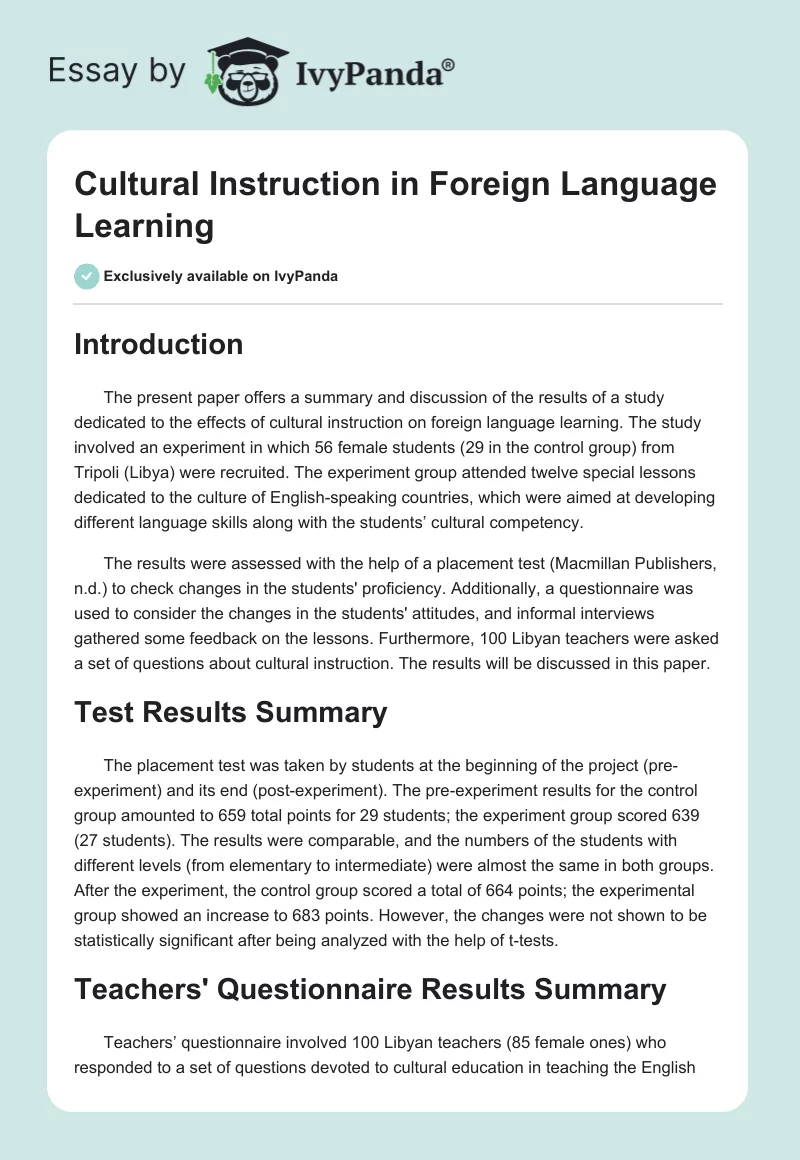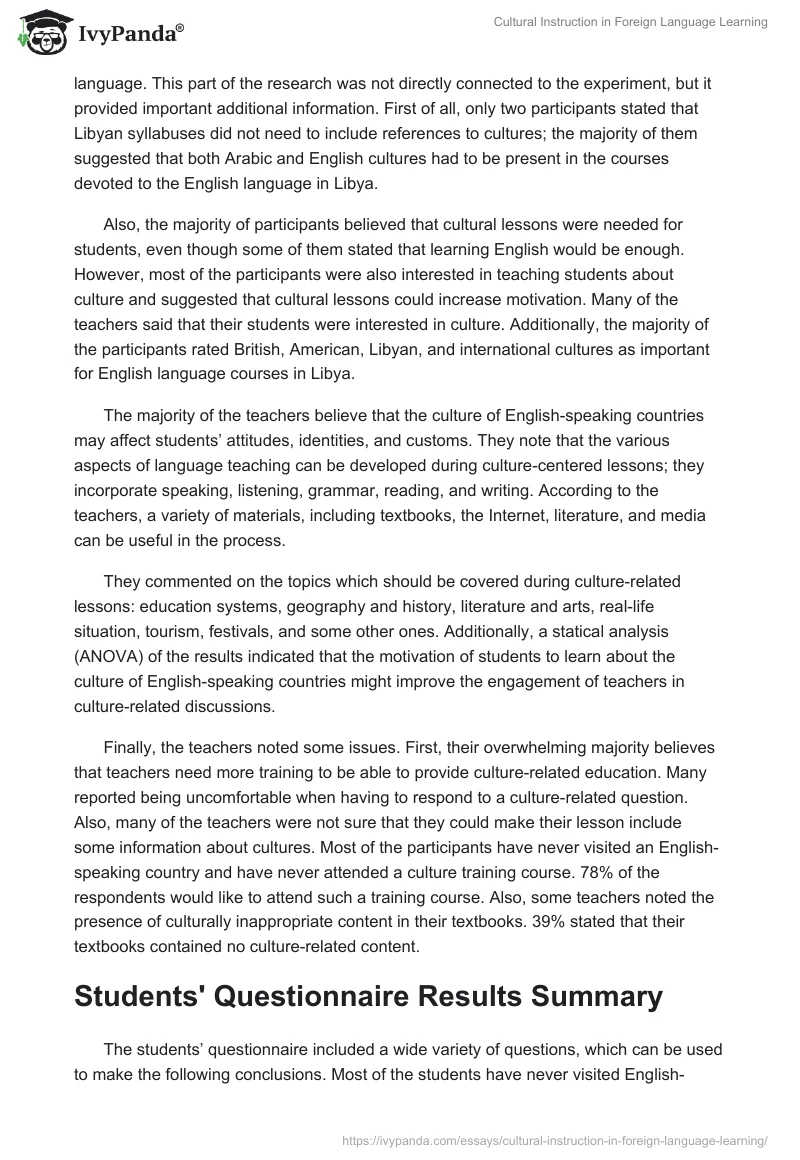Introduction
The present paper offers a summary and discussion of the results of a study dedicated to the effects of cultural instruction on foreign language learning. The study involved an experiment in which 56 female students (29 in the control group) from Tripoli (Libya) were recruited. The experiment group attended twelve special lessons dedicated to the culture of English-speaking countries, which were aimed at developing different language skills along with the students’ cultural competency.
The results were assessed with the help of a placement test (Macmillan Publishers, n.d.) to check changes in the students’ proficiency. Additionally, a questionnaire was used to consider the changes in the students’ attitudes, and informal interviews gathered some feedback on the lessons. Furthermore, 100 Libyan teachers were asked a set of questions about cultural instruction. The results will be discussed in this paper.
Test Results Summary
The placement test was taken by students at the beginning of the project (pre-experiment) and its end (post-experiment). The pre-experiment results for the control group amounted to 659 total points for 29 students; the experiment group scored 639 (27 students). The results were comparable, and the numbers of the students with different levels (from elementary to intermediate) were almost the same in both groups. After the experiment, the control group scored a total of 664 points; the experimental group showed an increase to 683 points. However, the changes were not shown to be statistically significant after being analyzed with the help of t-tests.
Teachers’ Questionnaire Results Summary
Teachers’ questionnaire involved 100 Libyan teachers (85 female ones) who responded to a set of questions devoted to cultural education in teaching the English language. This part of the research was not directly connected to the experiment, but it provided important additional information. First of all, only two participants stated that Libyan syllabuses did not need to include references to cultures; the majority of them suggested that both Arabic and English cultures had to be present in the courses devoted to the English language in Libya.
Also, the majority of participants believed that cultural lessons were needed for students, even though some of them stated that learning English would be enough. However, most of the participants were also interested in teaching students about culture and suggested that cultural lessons could increase motivation. Many of the teachers said that their students were interested in culture. Additionally, the majority of the participants rated British, American, Libyan, and international cultures as important for English language courses in Libya.
The majority of the teachers believe that the culture of English-speaking countries may affect students’ attitudes, identities, and customs. They note that the various aspects of language teaching can be developed during culture-centered lessons; they incorporate speaking, listening, grammar, reading, and writing. According to the teachers, a variety of materials, including textbooks, the Internet, literature, and media can be useful in the process.
They commented on the topics which should be covered during culture-related lessons: education systems, geography and history, literature and arts, real-life situation, tourism, festivals, and some other ones. Additionally, a statical analysis (ANOVA) of the results indicated that the motivation of students to learn about the culture of English-speaking countries might improve the engagement of teachers in culture-related discussions.
Finally, the teachers noted some issues. First, their overwhelming majority believes that teachers need more training to be able to provide culture-related education. Many reported being uncomfortable when having to respond to a culture-related question. Also, many of the teachers were not sure that they could make their lesson include some information about cultures. Most of the participants have never visited an English-speaking country and have never attended a culture training course. 78% of the respondents would like to attend such a training course. Also, some teachers noted the presence of culturally inappropriate content in their textbooks. 39% stated that their textbooks contained no culture-related content.
Students’ Questionnaire Results Summary
The students’ questionnaire included a wide variety of questions, which can be used to make the following conclusions. Most of the students have never visited English-speaking countries to practice English, but they are interested in the possibility. Also, very few of them had had a native speaker for an English language teacher. Additionally, most of the participants are generally interested in the cultures of the English-speaking countries and want to increase their intercultural competencies.
The participation in the experiment tended to increase the students’ interest in said cultures. Prior to the experiment and in the control group, the students reported little cultural content in their English language lessons; additionally, even after the experiment, many students remained dissatisfied with their textbooks. They reported that the textbooks had little cultural content. However, some of the students were to use other channels of getting familiar with other cultures, including the Internet and media.
After the experiment, the majority of the experimental group stated that the mentioned channels could be useful. The students also reported the usefulness of various tools for the teaching of the culture of English-speaking countries, which included the literature, Internet, media, discussions, and textbooks. Finally, the majority of the students supported the idea that cultural studies are important for language learning. The experiment tended to enhance the students’ interest in and understanding of cultural instruction.
Agreements and Disagreements between Teacher and Student Questionnaires
The students’ questionnaire was not identical to the one presented to teachers, but there were some similar aspects. In particular, the support of the notion of the study of culture was present in the responses to both questionnaires: both students and teachers view this perspective on English language teaching as important and express interest in it. Individual similarities may also be noted. For instance, many students supported the idea of using various tools like textbooks, media, and the Internet for English culture lessons, which was also promoted by the teachers. Furthermore, the students cited problems with textbooks the way teachers did as well.
However, the perspectives varied for different students and the control and experiment groups: in particular, the experiment group tended to demonstrate an increased understanding of cultural topics after the experiment. For the teachers, no such distinctions were made, although some discrepancies were found as well, indicating that different teachers may have different perspectives on culture-related topics. Still, given the views of the majority, the students and teachers coincide in the idea of the importance of culture for English language studying.
Agreement and Disagreements between Teacher and Student Interviews
Additionally, the research employed informal interviews to determine the students’ and teacher’s reaction to the lessons with and without cultural elements. In general, the teacher and students had similar perspectives, which mostly consisted of the approval of the lessons. According to the teacher, the cultural instruction improved the students’ engagement and motivation. She also stated that the students from the experimental group started to ask more questions and practice the language more willingly, which, from her perspective, may have affected their proficiency.
Similarly, the students from the experimental group reported enjoyment, interest, and excitement, stating that prior to the experiment, their English lessons were more boring. They also demonstrated the motivation to learn English. The students from the control group exhibited less motivation, but some stated that they were interested in English, even though the lessons did not engage them. Overall, the interviews indicate that the teacher and students agree that cultural lessons are more interesting than those without cultural instructions and may result in improved motivation. There are no direct disagreements between the results of the two procedures.
Discussion
The test results indicate that 12 sessions of cultural lessons have not improved the proficiency of the experimental group in a statistically significant way despite the noticeable changes in the scores. Future research may be able to determine if more prolonged exposure to the lessons or any other change in them can make the score differences more profound to the point where they will become statistically significant.
The results of the teacher’s questionnaires indicate that the majority of Libyan teachers view cultural education as important for English language lessons, but there are significant difficulties associated with their introduction, especially when training and learning resources are considered. Still, the advice of the teachers can be used in future to develop cultural content for Libyan students; the comments about the important areas and topics can be helpful in this regard.
The students’ questionnaire suggests that students are predominantly interested in studying culture but often encounter difficulties, including deficient materials (textbooks). Also, the students support the idea that cultural instruction is important, thus coinciding in their perspectives with the majority of teachers. The perspectives of students on the desired content of an English language course should also be taken into account when developing future culture-related lessons. As for the interviews, they present unambiguous results, indicating that students and the teacher approve of the program. According to them, it improves students’ motivation.
Also, the control group demonstrates a lack of motivation, which also proves the value of cultural lessons. In summary, despite the lack of statistically significant improvements in the English language proficiency of the experimental group, the study is promoting the development of an important element of English language education in Libya.
Conclusion
In summary, the presented study’s results indicate the following conclusions. The results of the test allow stating that 12 sessions of cultural lessons were unable to change the proficiency of the experimental group in a meaningful way. They also imply the need for additional research of more prolonged or otherwise altered lessons because a tendency for an increase in the experimental group score was noted. The students’ questionnaire also showed the interest of students in studying culture and related issues and beliefs, including the idea that cultural studies are important for language learning.
The teacher and students both have a positive reaction to the cultural lessons and report that it can increase motivation. Additionally, the teachers’ questionnaire also indicated the teachers’ support of the introduction of cultural lessons while pointing out the challenges associated with the process. Therefore, the present research demonstrated the value of cultural lessons and set the stage for future investigation in the field.
Reference
Macmillan Publishers. (n.d.). Placement tests. Web.


